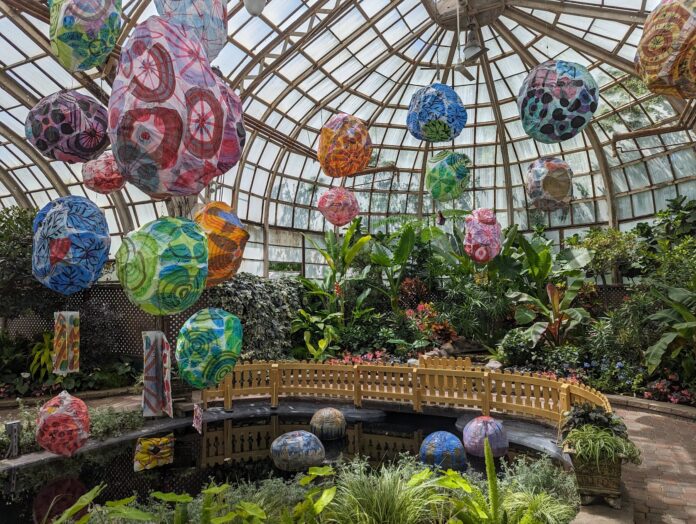This discusses a different perspective on educating about sustainability. It addresses concerns about over-consumption and contributing more to the problem instead of less.
I included an image above of the Franklin Park Conservatory in Columbus, Ohio. It often displays art and nature together.
“The Politics of Sustainability: Contemporary Art and Ecology” Excerpt
“One signal peril, indeed, is the tendency to accept the flattening of representation’s complexity and to surrender intellectual criticality in the face of the real urgency of climate change. The danger here is the public’s passive deferral of responsibility to scientific expertise and governmental authority, which makes us vulnerable both to solutions forged by exclusive social and political interests and to the forces of commercial exploitation that would use green rhetoric for the purposes of economic profit. And yet, if artists and cultural practitioners refuse to surrender their discerning consideration of scientific dictates, then what do they do, as Bruno Latour asks, when their methodological commitment to resisting the self-evidence of ‘truth’ prevents them from accepting the truth of impending ecological crisis, which potentially allies them with climate-change sceptics? Facing this dilemma, one must be aware of the fact that whatever we know about the environment – knowledge that will determine our future actions and chances of survival – we owe to the diverse practices and institutions that represent it. As such, we can perhaps only affirm the need for a critical realism that both refuses to relinquish the validity of scientific paradigms and remains dedicated to a guardedly analytical approach to ecological discourse as a system of representations forged at the intersection of power and knowledge.
Finally, one must also confront the troubling observation that exhibitions dedicated to sustainability are fundamentally contradictory; for even as they seek to address climate change and work towards creative solutions – although certainly not all projects are equally politically or pedagogically inclined – they contribute to the very problem of global warming by virtue of their own carbon footprint, the results of transporting artworks, maintaining the exhibition space’s climate control and printing catalogs. One might conclude that eco-art exhibitions are simply unviable from an environmental perspective. Yet if this response is both inadequate and unrealistic – as much as it would be to insist on immediately discontinuing all unsustainable technologies, rather than working gradually towards a state of sustainability – we need at the very least to consider just what justifies the continuation of unsustainable art exhibitions committed to the subject of sustainability.
Extrapolating from this last point, even while exhibitions dedicated to sustainability, such as Beyond Green, may themselves be unsustainable from the perspective of global warming, exhibitions focusing on art and ecology nonetheless remain urgent at this time. To contribute to the ongoing public engagement with the politics of sustainability, to advance creative proposals for alternative forms of life based on environmental justice in a global framework, and to do so until such art exhibitions can somehow meet the requirements of a just sustainability – these are the imperatives for a contemporary environmental art.” (Demos 2009).
.
REVIEW
This paper is incredibly important to reference in my project. It outlines the problematic ways that sustainability as a concept exists by questioning who benefits from the push of sustainability and the ignorance that the West has towards dumping our excess consumption onto 3rd world countries. It provides art and ecological examples that push this perspective. At the same time, it ends the paper with an optimistic note detailing the importance of creating exhibits related to engaging the public with sustainability. This grounds me as a reader in recognizing the issue is larger than the surface level, and considering the goods and bads of sustainable education is the way I need to consider my project. I have to think of the identity of the public, the possibility of creating more waste or greenhouse gasses, and the worth of that to explore sustainability as a tool. Recognizing that “irony,” as the paper calls it, is crucial to making sure I realize the full extent of the problem and what I can control in it.
REFERENCES
Demos, T. J. “The Politics of Sustainability: Contemporary Art and Ecology.” In Radical Nature: Art and Architecture for a Changing Planet 1969–2009, published in conjunction with the exhibition of the same name, shown at the Barbican Art Gallery, edited by Francesco Manacorda, 16–30. London: Barbican Art Gallery, 2009. http://www.environmentandsociety.org/node/3417.




